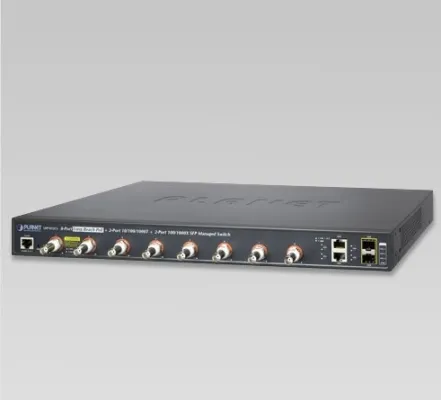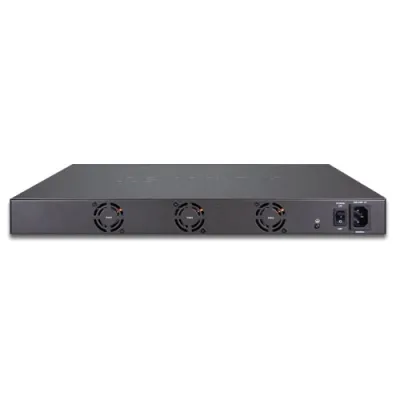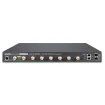The Long Reach PoE Solution enables all enterprises and network service providers to set up an IP infrastructure in a remote location where 802.3af/at PoE compliant powered devices can receive both data and power via Planet switches, and LRP extenders and injectors over a long distance but not limited to the normal 100 meters.
Long Reach PoE Switch over Coaxial-based Network
The LRP-822CS is a multi-channel Long Reach PoE Switch that extends Ethernet and PoE networking up to 1,000 meters over existing coaxial cables that connect to multiple PoE-enabled network applications, such as PoE IP cameras. The LRP-822CS provides IPv6 / IPv4 dual stack management and a built-in L2/L4 Gigabit Switching engine. The unit features 8 BNC ports that support Long Reach PoE, 2 Gigabit copper ports and 2 additional 100/1000BASE-X SFP fiber slots. Each BNC port provides 36 watts of power yielding a total power budget of up to 240 watts. The LRP-822CS features intelligent PoE management functions that improve the availability of critical applications. The unit provides a quick, safe and cost-effective PoE network solution to upgrade existing coaxial cable infrastructures from an analog system to an HD IP surveillance system.
Multi-Channel Long Reach Power over Ethernet
The LRP-822CS operates with Long Reach PoE Extenders, such as the LRP-101CE, via its BNC ports. Each of the BNC ports features long range data and power transmission for distances of up to 1,000m (3,280ft) over coaxial cable to an LRP Extender, and an additional 100m over Ethernet cable to an 802.3at/at -compliant powered device (PD). With its centrally-managed 240-watt PoE budget, the LRP-822CS eliminates the need for additional power on remote sites allowing a single power source to provide power to both LRP extenders and the PoE powered devices at long distances. The Long Reach PoE switch simplifies deployment of powered devices reducing the expense of having to install additional power sources at the remote site of a deployment.
Multiple Node Support
Our Long Reach PoE switch solution can easily build a power system for centrally-controlled IP cameras. The unit gives users the flexibility of expanding a small area network with BNC T-connectors to share up to four nodes per port when needed. The LRP-822CS with 8 BNC Long Reach PoE Ports can support up to 32 low-voltage IP cameras. Administrators need to be aware though that the LRP-822CS has a total PoE power budget of up to 240 watts.
Advanced PoE Management
The LRP-822CS features advanced PoE management functions. With Intelligent Powered Device Alive Check, the LRP-822CS will ping inactive Powered Devices (PD) to re-active them. With the Scheduled Power Recycling, the LRP-822CS will automatically reboot at a pre-specified time to prevent PDs from crashing due to buffer overflow. The PoE Schedule function allows network administrators to pre-schedule power feeding times for each PoE port. PoE Usage Monitoring allows the LRP-822CS to monitor the status of the power usage of the connected PDs in real time. With its PoE Over-Temperature Protection System, the unit prevents overheating by limiting the amount of output power. The LRP-822CS features a 19-inch metal housing, that offers a noise-free operation with an effective ventilation system. Its smart fan technology automatically controls the speed of its built-in fan to reduce noise and maintain the temperature of the PoE switch.
Powerful Layer 2 Features
The LRP-822CS can be programmed for advanced switch management functions such as dynamic port link aggregation, 802.1Q VLAN and Q-in-Q VLAN, Multiple Spanning Tree Protocol (MSTP), Loop and BPDU Guard, IGMP Snooping, and MLD Snooping. Via the link aggregation, the LRP-822CS allows the operation of a high-speed trunk to combine with multiple ports such as an 8Gbps fat pipe, and supports fail-over as well. Also, the Link Layer Discovery Protocol (LLDP) is the Layer 2 Protocol included to help discover basic information about neighboring devices on the local broadcast domain.
Optimal Traffic Control
The LRP-822CS offers powerful traffic management features with QoS, broadcast / multicast storm control, per port bandwidth control, IP DSCP QoS priority and remarking. This preserves the quality for VoIP and video streaming transmission and empowers the enterprises to take full advantage of the limited network resources.
Maximum Network Security
PLANET LRP-822CS offers comprehensive IPv4 / IPv6 Layer 2 to Layer 4 Access Control List (ACL) for enforcing security to the edge. It can be used to restrict network access by denying packets based on source and destination IP address, TCP/UDP ports or defined typical network applications. Its protection mechanism also comprises 802.1X port-based user and device authentication, which can be deployed with RADIUS to ensure port level security and block illegal users. With the Protected Port function, communication between edge ports can be prevented to guarantee user privacy. The Port Security function limits the number of network devices on a given port. The LRP-822CS also provides DHCP Snooping, IP Source Guard and Dynamic ARP Inspection functions to prevent IP snooping and discard ARP packets with invalid MAC address.
User Friendly Management
The LRP-822CS supports console, Web, Telnet and SNMP management interfaces. With its built-in Web-based management interface, the LRP-822CS offers an easy-to-use, platform-independent management and configuration facility. By supporting the standard Simple Network Management Protocol (SNMP), the switch can be managed via any standard management software. For text-based management, the switch can be accessed via Telnet and the console port. Moreover, the LRP-822CS offers secure remote management by supporting SSH, SSL and SNMP v3 connections which encrypt the packet content at each session.
Long-Distance SFP support
The LRP-822CS provides two Gigabit TP interfaces supporting 10/100/1000BASE-T RJ45 interfaces. Via its two dual-speed fiber SFP slots, the units can connect with the 100BASE-FX / 1000BASE-SX/LX SFP (Small Form-factor Pluggable) fiber transceivers to uplink to the backbone of a switch. Distances can be extended from 550 meters to 2 kilometers (multi-mode fiber) and up to 10/20/30/40/50/70/120 kilometers (single-mode fiber or WDM fiber). The LRP-822CS also supports SFP-DDM (Digital Diagnostic Monitor) function that can easily monitor real-time parameters of the SFP for network administrator, such as optical output power, optical input power, temperature, laser bias current and transceiver supply voltage.
Features:
- Copper: 2 x 10/100/1000BASE-T RJ45
- Fiber Optic: 2 x 100/1000BASE-X SFP slot
- Connectivity: 8 x BNC female connectors
- Power Output: 54V DC, 36 watts max. per port
- Total Power Budget: 240 watts max. / 25°C
- Max. Distance: 200m w/ PoE+ output (656ft.), 400m w/ PoE output (1,312ft.), 1200m w/0 PoE output (3,937ft.)
- TAA Compliant
| Hardware Specifications | |||||||||||||||||||||||||||||||
| Ethernet Interfaces | – Copper: 2 x 10/100/1000BASE-T RJ45 Auto-negotiation/ Auto-MDI/MDI-X- Fiber Optic: 2 x 100/1000BASE-X SFP slot Supports 100/1000Mbps dual mode and DDM- Jumbo Frame: 10Kbytes with GE1 to GE4 | ||||||||||||||||||||||||||||||
| Long Reach PoE Interfaces | – Connectivity:
– Cabling: – Maximum Distance: – Long Reach Ethernet Standard: – Modulation Type: – Security: – Frequency Band: – Performance:
* The actual data rate and PoE output vary on the quality of the copper wire and environmental factors. The performance result above is based on the testing via the RG-6/U coaxial cable. ** TX: LRP-822CS to LRP-101CE; RX: LRP-101CE to LRP-822CS. – Multiple Nodes: * The actual extender nodes vary on the quality of the copper wire and environmental factors. – LRP Compatibility: | ||||||||||||||||||||||||||||||
| Console | 1 x RS232-to-RJ45 serial port (115200, 8, N, 1) | ||||||||||||||||||||||||||||||
| Switch Architecture | Store-and-Forward | ||||||||||||||||||||||||||||||
| Switch Fabric | 9.6Gbps / non-blocking | ||||||||||||||||||||||||||||||
| Address Table | 8K entries | ||||||||||||||||||||||||||||||
| Shared Data Buffer | 4.1 megabits | ||||||||||||||||||||||||||||||
| Flow Control | IEEE 802.3x pause frame for full-duplex Back pressure for half-duplex | ||||||||||||||||||||||||||||||
| Reset Button | < 5 sec: System reboot > 5 sec: Factory default | ||||||||||||||||||||||||||||||
| LED | PWR, SYS, LNK, PoE-in-Use, 1000, LNK/ACK, Fan 1 Alert, Fan 2 Alert, PoE PWR Alert | ||||||||||||||||||||||||||||||
| Dimensions (W x D x H) | 440 x 300 x 44.5 mm, 1U height | ||||||||||||||||||||||||||||||
| Weight | 3878g | ||||||||||||||||||||||||||||||
| Power Requirements | AC 100~240V, 50/60Hz, auto-sensing | ||||||||||||||||||||||||||||||
| ESD Protection | 6KV DC | ||||||||||||||||||||||||||||||
| Power Consumption | 320 watts / 1091.8 BTU | ||||||||||||||||||||||||||||||
| Enclosure | Metal | ||||||||||||||||||||||||||||||
| Layer 2 Functions | |||||||||||||||||||||||||||||||
| Port Mirroring | TX / RX / both Many-to-1 monitor | ||||||||||||||||||||||||||||||
| VLAN | 802.1Q tagged-based VLAN Up to 256 VLAN groups, out of 4094 VLAN IDs 802.1ad Q-in-Q tunneling Voice VLAN Protocol VLAN Private VLAN (Protected port) GVRP | ||||||||||||||||||||||||||||||
| Link Aggregation | IEEE 802.3ad LACP and static trunk Supports 4 groups of 4-port trunk | ||||||||||||||||||||||||||||||
| Spanning Tree Protocol | STP / RSTP / MSTP | ||||||||||||||||||||||||||||||
| IGMP Snooping | IGMP (v2/v3) Snooping IGMP Querier Up to 256 multicast groups | ||||||||||||||||||||||||||||||
| MLD Snooping | MLD (v1/v2) Snooping, up to 256 multicast groups | ||||||||||||||||||||||||||||||
| Access Control List | IPv4/IPv6 IP-based ACL / MAC-based ACL | ||||||||||||||||||||||||||||||
| QoS | 8 mapping ID to 8 level priority queues – Port number – 802.1p priority – 802.1Q VLAN tag – DSCP field in IP packet Traffic classification based, strict priority and WRR | ||||||||||||||||||||||||||||||
| Security | IEEE 802.1X: Port-based authentication Built-in RADIUS client to co-operate with RADIUS server RADIUS / TACACS+ user access authentication IP-MAC port binding MAC filter Static MAC address DHCP Snooping and DHCP Option82 STP BPDU guard, BPDU filtering and BPDU forwarding DoS attack prevention ARP inspection IP source guard | ||||||||||||||||||||||||||||||
| Management Functions | |||||||||||||||||||||||||||||||
| Basic Management Interfaces | Web browser / Telnet / SNMP v1, v2c Firmware upgrade by HTTP / TFTP protocol through Ethernet network Remote / Local Syslog System log LLDP protocol SNTP | ||||||||||||||||||||||||||||||
| Secure Management Interfaces | SSH, SSL, SNMP v3 | ||||||||||||||||||||||||||||||
| SNMP MIBs | RFC 1213 MIB-II RFC 1215 Generic Traps RFC 1493 Bridge MIB RFC 2674 Bridge MIB Extensions RFC 2737 Entity MIB (Version 2) RFC 2819 RMON (1, 2, 3, 9) RFC 2863 Interface Group MIB RFC 3635 Ethernet-like MIB | ||||||||||||||||||||||||||||||
| Standards Conformance | |||||||||||||||||||||||||||||||
| Regulation Compliance | FCC Part 15 Class A, CE | ||||||||||||||||||||||||||||||
| Standards Compliance | IEEE 1901 Broadband Power Line IEEE 802.3 10BASE-T IEEE 802.3u 100BASE-TX/100BASE-FX IEEE 802.3z Gigabit SX/LX IEEE 802.3ab Gigabit 1000T IEEE 802.3x flow control and back pressure IEEE 802.3ad port trunk with LACP IEEE 802.1D Spanning Tree Protocol IEEE 802.1w Rapid Spanning Tree Protocol IEEE 802.1s Multiple Spanning Tree Protocol IEEE 802.1p Class of Service IEEE 802.1Q VLAN tagging IEEE 802.1X Port Authentication Network Control IEEE 802.1ab LLDP RFC 768 UDP RFC 793 TFTP RFC 791 IP RFC 792 ICMP RFC 2068 HTTP RFC 1112 IGMP version 1 RFC 2236 IGMP version 2 RFC 3376 IGMP version 3 RFC 2710 MLD version 1 RFC 3810 MLD version 2 | ||||||||||||||||||||||||||||||
| Environment | |||||||||||||||||||||||||||||||
| Operating | Temperature: 0 ~ 50 degrees C Relative Humidity: 5 ~ 95% (non-condensing) | ||||||||||||||||||||||||||||||
| Storage | Temperature: -10 ~ 70 degrees C Relative Humidity: 5 ~ 95% (non-condensing) | ||||||||||||||||||||||||||||||






